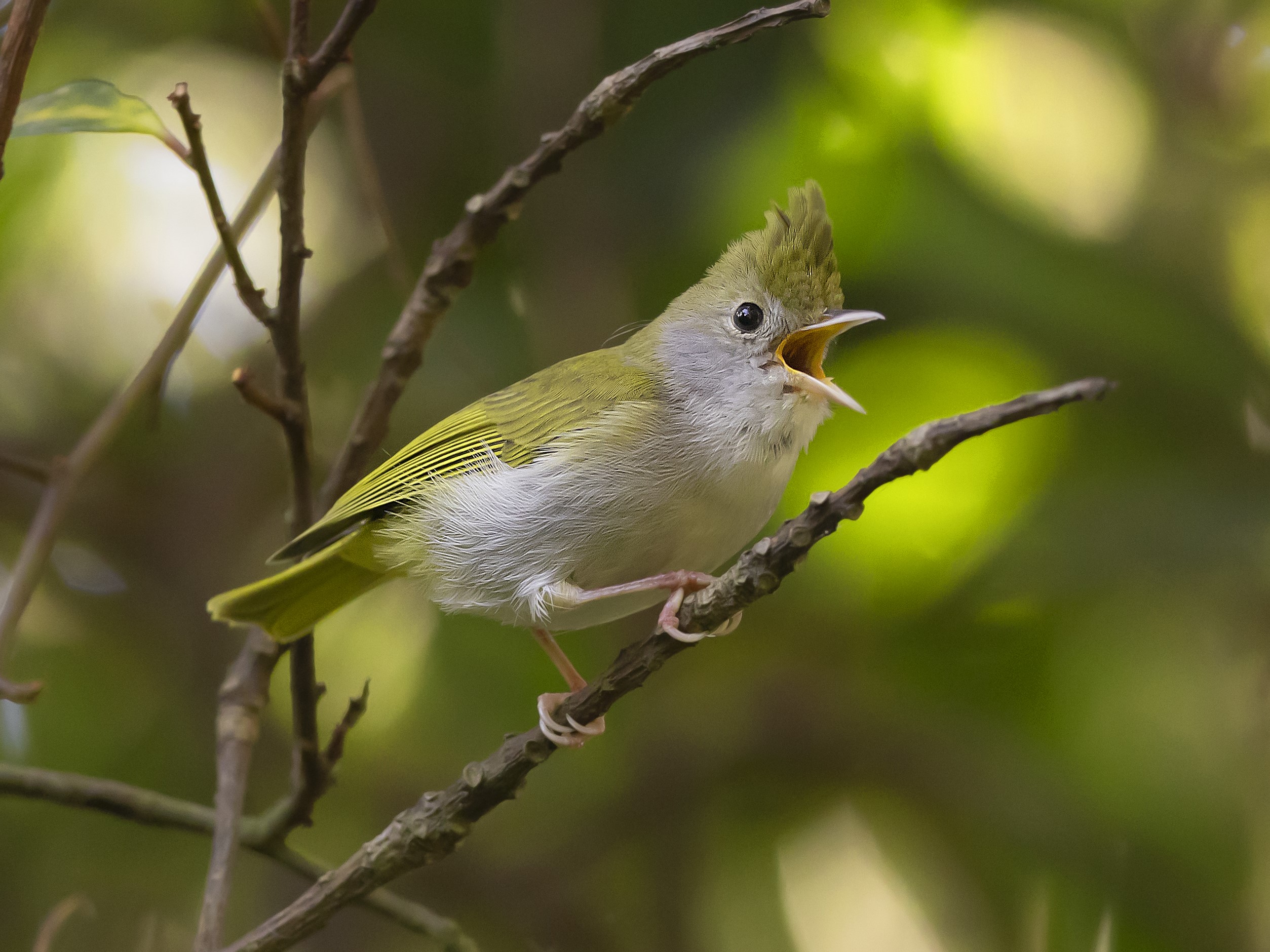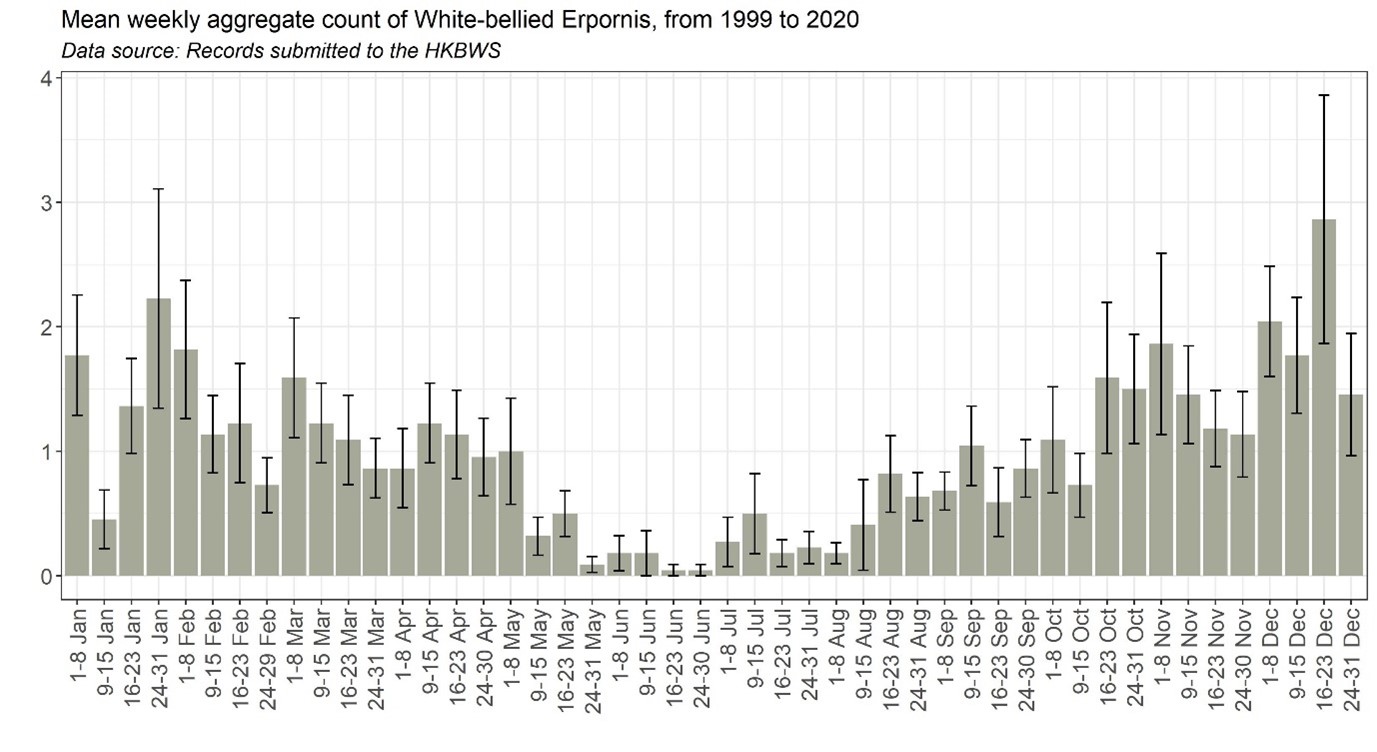White-bellied Erpornis Erpornis zantholeuca 白腹鳳鶥
Category I. Scarce and localised forest resident in the New Territories.
IDENTIFICATION

Dec. 2012, James Kwok.
11-13 cm. Small passerine with a conspicuous crest and dark eye in pale greyish face; yellowish-green above and greyish-white below with a yellow vent. Fairly strongly tapered, pointed bill, legs short and pale. Sexes alike.
VOCALISATIONS
Utters a variety of calls, some rather nasal or Parus-like but also a distinctive rising clear ‘see-see-siree’ or a more drawn out and softer ‘chi-r-r-r-r-r-r-ree’.
It is unclear which vocalisation constitutes the song. Collar and Robson (2020) state it is “a short high-pitched descending trill, “si’i’i’i’i’i”, or rising and falling “ss ss ss se se se se”, or only rising and with rapid delivery (trilled), “chechecheche””. Such sounds can be heard in the recordings above. However, more complex vocalisations such as this one may also be encountered and could conceivably constitute the song.
DISTRIBUTION & HABITAT PREFERENCE
Largely restricted to mature woodland, most commonly on the Tai Mo Shan massif, in Sai Kung and the northeast New Territories. The increase in woodland habitat has allowed this species to expand its range over the last few decades. However, it remains almost entirely a mainland species, with only one record elsewhere, at Mount Davis on HK Island on 24 November 2018. It remains absent on Lantau despite its substantial area of mature woodland. There are also a few records in urban parks with high vegetation cover such as Kowloon Park and Tsing Yi West Road Park, as well as park-type habitat in urban Ho Man Tin.
Although it was not easily detected in the breeding and winter atlases, probably because it occurs at low densities and is of inconspicuous appearance and habits (when not vocalising), its range increased from 0.24% to 0.41% of 1km squares as measured by the breeding bird surveys of 1993-96 and 2016-19. The increase in distribution was due to range expansion in Tai Po Kau and Sai Kung. Similarly, its non-breeding season range increased from 0.42% to 0.70% between the winter atlas of 2001-05 to that of 2016-19. In that season its recorded range expanded to Lion Rock and Tai Lam Country Parks and the northeast New Territories.
OCCURRENCE
White-bellied Erpornis was first recorded on 15 November 1980 at Tai Po Kau. The local population slowly established and later spread to nearby wooded sites such as Shing Mun.
Although there is a slight seasonal pattern to the observations (Figure 1), with rather few sightings between May and August, this is likely to be an artefact of the distribution of observer activity. There is no indication of regular immigration in autumn, nor does this species appear to move out of its favoured forest habitat in winter.
BREEDING
The first breeding record was in 1983 at Tai Po Kau, which was repeated at Shing Mun. Fledgling were also observed at Wu Kau Tang on 19 May 2000. It is probably breeding at all sites from which it is regularly recorded.
BEHAVIOUR, FORAGING & DIET
Most sightings refer to groups of one to four birds, sometimes in mixed flocks in winter; a flock of 15 at Tai Po Kau on 2 September 1990 remains exceptional. There are few data regarding diet, but it is an arboreal forager usually seen in the middle canopy. It can be very vocal while foraging, frequently uttering contact or other vocalisations.
RANGE & SYSTEMATICS
Resident from the Himalayas east to Indochina, south China and southeast Asia including Borneo but not the Philippines (Collar and Robson 2020). Only one subspecies, E. z. griseiloris, occurs in southeast China, including HK, and Taiwan.
CONSERVATION STATUS
IUCN: Least Concern. Population trend unknown.
Figure 1.

Collar, N. and C. Robson (2020). White-bellied Erpornis (Erpornis zantholeuca), version 1.0. In Birds of the World (J. del Hoyo, A. Elliott, J. Sargatal, D. A. Christie, and E. de Juana, Editors). Cornell Lab of Ornithology, Ithaca, NY, USA. https://doi.org/10.2173/bow.whbyuh1.01

